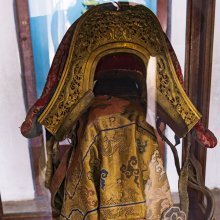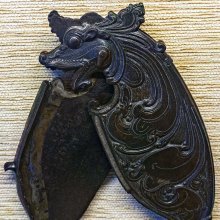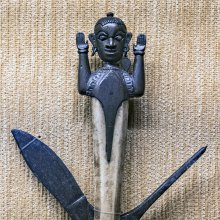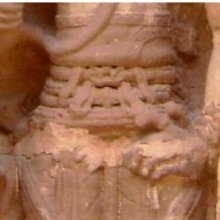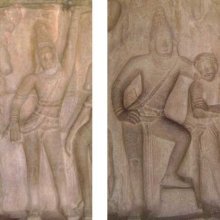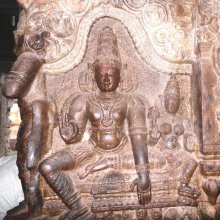Kati, Kaṭi, Kaṭī, Kāti: 34 definitions
Introduction:
Kati means something in Buddhism, Pali, Hinduism, Sanskrit, the history of ancient India, Marathi, Hindi, biology, Tamil. If you want to know the exact meaning, history, etymology or English translation of this term then check out the descriptions on this page. Add your comment or reference to a book if you want to contribute to this summary article.
Images (photo gallery)
(+178 more images available)
In Hinduism
Natyashastra (theatrics and dramaturgy)
Source: Wisdom Library: Nāṭya-śāstraKaṭi (कटि) refers to “waist”, “hip” or “buttocks”. It is one of the six major limbs (aṅga) used in dramatic performance, according to the Nāṭyaśāstra chapter 8. With these limbs are made the various gestures (āṅgika), which form a part of the histrionic representation (abhinaya).
There are five different kinds of “movements of the waist (kaṭi)” defined:
- chinnā (turned aside),
- nivṛttā (turned round),
- recitā (moved about),
- prakampitā / kampitā (shaken),
- udvāhitā (raised)
Kaṭi (कटि, “waist”) refers to the “two sides of the waist” representing one of the seven “major limbs” (aṅga), which represents a division of Āṅgikābhinaya (gesture language of the limbs) as used within the classical tradition of Indian dance and performance, also known as Bharatanatyam.—Āṅgika-abhinaya is the gesture language of the limbs. Dance is an art that expresses itself through the medium of body, and therefore, āṅgikābhinaya is essential for any dance and especially for any classical dance of India. Aṅgas or major limbs include the head, hands, chest, sides, waist (viz., Kaṭi), and feet; at times the neck is also used as a separate limb.
Kaṭi refers to the “movements of the hip”.—In Bharatanatyam, according to Abhinayadarpaṇa, there are no descriptions of the movements of the hip and the waist. However, in Nāṭyaśāstra, there are five movements each of the sides and the hip.
The movements of the hip (kaṭi) are:—
- chinna (turned aside),
- nivṛtta (turned up),
- recita (moved about),
- kaṃpita (shivering),
- udvāhita (lifted up).
Kaṭi (कटि) refers to “movements of the waist” (in Sanskrit Dramas), as conveyed through Āṅgikābhinaya: one of the four divisions of Abhinaya or “ways to convey or represent one’s emotion to others”, according to the Viṣṇudharmottarapurāṇa, an ancient Sanskrit text which (being encyclopedic in nature) deals with a variety of cultural topics such as arts, architecture, music, grammar and astronomy.—The term kaṭi is used to denote the waist part in Sanskrit. This word is used in both masculine and feminine gender in Sanskrit. The Viṣṇudharmottarapurāṇa seems to take the word kaṭi in feminine gender and makes the divisions of waist movements in feminine gender.
Five types of waist movements are accepted here. These are—
- prakampitā,
- vicchinā,
- nivṛttā,
- recitā and
- udvāhitā.

Natyashastra (नाट्यशास्त्र, nāṭyaśāstra) refers to both the ancient Indian tradition (shastra) of performing arts, (natya—theatrics, drama, dance, music), as well as the name of a Sanskrit work dealing with these subjects. It also teaches the rules for composing Dramatic plays (nataka), construction and performance of Theater, and Poetic works (kavya).
Shilpashastra (iconography)
Source: Shodhganga: The significance of the mūla-beras (śilpa)Kaṭi (कटि) or Kaṭihasta refers to “hip” and represents one of the twenty-four gestures with a single hand, as defined according to texts dealing with śilpa (arts and crafs), known as śilpaśāstras.—Accordingly, pratimā-lakṣaṇa (body postures of the icons) is comprised of hand gestures (hasta, mudrā or kai-amaiti), stances/poses (āsanas) and inflexions of the body (bhaṅgas). There are thirty-two types of hands [viz., kaṭi-hasta] classified into two major groups known as tolirkai (functional and expressive gestures) and elirkai (graceful posture of the hand).
Source: Shodhganga: Elements of Art and Architecture in the Trtiyakhanda of the Visnudharmottarapurana (shilpa)Kaṭi (कटि) or “hip” refers to one of the various body parts whose Measurements should follow the principles of ancient Indian Painting (citra), according to the Viṣṇudharmottarapurāṇa, an ancient Sanskrit text which (being encyclopedic in nature) deals with a variety of cultural topics such as arts, architecture, music, grammar and astronomy.—In the Viṣṇudharmottarapurāṇa, a specific measurement of every limb of a man as well as of a woman is elaborately and systematically discussed. In this book, the writer has presented the measurement of almost all the body parts that should be maintained in a picture. For example, Kaṭi (“hip”) should be 18 aṅgulas (breadth) and 44 aṅgulas (circumference).

Shilpashastra (शिल्पशास्त्र, śilpaśāstra) represents the ancient Indian science (shastra) of creative arts (shilpa) such as sculpture, iconography and painting. Closely related to Vastushastra (architecture), they often share the same literature.
Ayurveda (science of life)
Source: gurumukhi.ru: Ayurveda glossary of termsKaṭi (कटि):—[kaṭiḥ/kaṭī] (1) Loins, lumbus. (2) Pelvis. (3) Waist |

Āyurveda (आयुर्वेद, ayurveda) is a branch of Indian science dealing with medicine, herbalism, taxology, anatomy, surgery, alchemy and related topics. Traditional practice of Āyurveda in ancient India dates back to at least the first millenium BC. Literature is commonly written in Sanskrit using various poetic metres.
Shaivism (Shaiva philosophy)
Source: Google Books: Manthanabhairavatantram (shaivism)Kaṭi (कटि) refers to the “hips”, according to the Śrīmatottara-tantra, an expansion of the Kubjikāmatatantra: the earliest popular and most authoritative Tantra of the Kubjikā cult. Accordingly, “O goddess, Svacchanda is in the middle, within the abode of the triangle. Very powerful, he has five faces with three times five flaming eyes. [...] He sits on a great lotus and is adorned with a belt on his hips [i.e., kaṭi-mekhala-maṇḍita]. He is adorned with small bells and a garland of gems. There are anklets on his feet and they are well adorned with necklaces of pearls. He sits on Ananta as a seat and is like heated gold. On Ananta’s seat are seventy billion mantras. He is beautiful, divine, (white) like the stars, snow and the moon.]. [...]”.
Source: Brill: Śaivism and the Tantric TraditionsKaṭi (कटि) refers to the “hips”, according to the Guhyasūtra chapter 9.—Accordingly, “[...] [The Lord spoke]:—[...] On one half, there should be a forehead mark; on one half a [forehead] eye. A ring [should be] in one ear; a [pendant] ear-ornament in one ear. He should put a trident in his right hand and a breast on his left side, a girdle on the left half, a bangle on the left arm, a woman’s anklet on the left leg, a man’s anklet on the right leg and a muñja-grass belt. At the hips (kaṭi), he should put a loin-cloth on the right and wear a woman’s garment on the left.”.
Source: SOAS University of London: Protective Rites in the Netra TantraKaṭi (कटि) refers to the “hips”, according to the Netratantra of Kṣemarāja: a Śaiva text from the 9th century in which Śiva (Bhairava) teaches Pārvatī topics such as metaphysics, cosmology, and soteriology.—Accordingly, [verse 11.1-24ab, while describing the appearance and worship of Tumburu]—“[...] [He worships] Deva as Tumburu in the middle of an eight petaled lotus, in the maṇḍala, [starting] in the East, O Devī. [...] He [has] a half-moon in his topknot, sits in the blue lotus Āsana. [Tumburu is] white like a drop of frosty jasmine, similar to mountain snow. [He wears] a serpent as a sacred thread and is adorned with snake ornaments. [Tumburu is] adorned with all jewels, a tiger skin on the ground [below his] hips (vyāghracarman-kaṭi-sthala), a garment of elephant skin, mounted on a very strong bull, and wears a rhino hide. [...]”.

Shaiva (शैव, śaiva) or Shaivism (śaivism) represents a tradition of Hinduism worshiping Shiva as the supreme being. Closely related to Shaktism, Shaiva literature includes a range of scriptures, including Tantras, while the root of this tradition may be traced back to the ancient Vedas.
Shaktism (Shakta philosophy)
Source: Google Books: ManthanabhairavatantramKaṭi (कटि) refers to the “buttock”, according to the Jayadrathayāmala verse 2.26.23cd-30ab.—Accordingly, “Now I will tell (you) the supreme teaching concerning Carcikā by just knowing which one attains every accomplishment. One should visualize (Carcikā) as very thin (and old), her face brilliant and frightening with her fierce gaze. She is (dark) like black lightning and is engaged in devouring the triple world. She has one face and three eyes and two arms and is adorned with a corpse. She is mounted on a buffalo and leather made of human skin is (under her) buttock (naracarman-kaṭi-sthalā). (Her) garland is made of human entrails and (she is) adorned with snakes”.

Shakta (शाक्त, śākta) or Shaktism (śāktism) represents a tradition of Hinduism where the Goddess (Devi) is revered and worshipped. Shakta literature includes a range of scriptures, including various Agamas and Tantras, although its roots may be traced back to the Vedas.
Vastushastra (architecture)
Source: Brill: Śaivism and the Tantric Traditions (architecture)Kaṭi (कटि) [=kaṭija?] refers to the “buttocks” (i.e. coccyx?), according to the Devyāmata (in the section śalyoddhāra-paṭala or “excavation of extraneous substances”).—Accordingly, “[...] If [someone] touches his buttocks (kaṭi—kaṭijaṃ kaṭisaṃsparśād), there is [an extraneous thing] arising from the buttocks (kaṭija) [, i.e. coccyx?] or an iron nail at a depth of two cubits [underground]. [The officiant] should remove that extraneous thing from there. If [someone] scratches his thigh, there is an extraneous thing related to the thigh or piece of wood at a depth of one and a half cubits. [The officiant] should remove it carefully. [...]”.
Source: Shodhganga: Elements of Art and Architecture in the Trtiyakhanda of the Visnudharmottarapurana (vastu)Kaṭi (कटि) refers to the “hip” portion of the Hindu Temple, according to the Viṣṇudharmottarapurāṇa, an ancient Sanskrit text which (being encyclopedic in nature) deals with a variety of cultural topics such as arts, architecture, music, grammar and astronomy.—Kaṭi means the hip part of a building. According to the Viṣṇudharmottarapurāṇa, kaṭi i.e., the hip part of the temple should be half of the entire height of the temple. But according to the Bṛhatsaṃhitā, the hip portion of a temple should be equal to one third of its height. Again, the Matsyapurāṇa also keeps its view point in the same spirit with that in the Bṛhatsaṃhitā. It shows that though the term kaṭi has been used to mean the fixed portion of a temple in all treatises differences can be seen to ascertaining its heights in different works.

Vastushastra (वास्तुशास्त्र, vāstuśāstra) refers to the ancient Indian science (shastra) of architecture (vastu), dealing with topics such architecture, sculpture, town-building, fort building and various other constructions. Vastu also deals with the philosophy of the architectural relation with the cosmic universe.
Purana and Itihasa (epic history)
Source: archive.org: Shiva Purana - English TranslationKaṭi (कटि) refers to the “hips” (of all the gods), according to the Śivapurāṇa 2.4.17 (“The Resuscitation of Gaṇeśa”).—Accordingly, as the Gods discussed: “Only when the goddess Pārvatī is pleased can there be a relief; not otherwise, even with our maximum efforts. Even Śiva who is an expert in different sports and is deluding us all, seems distressed like an ordinary man. When the hips (kaṭi) of all the gods are broken and Pārvatī is fiery in rage, none of them dare stand before her. [...]”

The Purana (पुराण, purāṇas) refers to Sanskrit literature preserving ancient India’s vast cultural history, including historical legends, religious ceremonies, various arts and sciences. The eighteen mahapuranas total over 400,000 shlokas (metrical couplets) and date to at least several centuries BCE.
In Buddhism
Mahayana (major branch of Buddhism)
Source: Wisdom Library: Maha Prajnaparamita SastraKaṭi (कटि, “hip”) refers to the “two hips”, from which the Buddha emitted numerous rays when he smiled with his whole body after contemplating the entire universe, according to the 2nd century Mahāprajñāpāramitāśāstra (chapter XIV).—Accordingly, having himself arranged the lion-seat, the Bhagavat sat down cross-legged; holding his body upright and fixing his attention, he entered into the samādhirājasamādhi. Then, having tranquilly come out of this samādhi and having contemplated the entire universe with his divine eye (divyacakṣus), the Bhagavat smiled with his whole body. Wheels with a thousand spokes imprinted on the soles of his feet (pādatala) shoot out six hundred prabhedakoṭi of rays. In the same way, beams of six hundred prabhedakoṭi of rays are emitted from his two hips (kaṭi).

Mahayana (महायान, mahāyāna) is a major branch of Buddhism focusing on the path of a Bodhisattva (spiritual aspirants/ enlightened beings). Extant literature is vast and primarely composed in the Sanskrit language. There are many sūtras of which some of the earliest are the various Prajñāpāramitā sūtras.
Tibetan Buddhism (Vajrayana or tantric Buddhism)
Source: MDPI Books: The Ocean of HeroesKaṭi (कटि) refers to the “hips”, according to the 10th-century Ḍākārṇava-tantra: one of the last Tibetan Tantric scriptures belonging to the Buddhist Saṃvara tradition consisting of 51 chapters.—Accordingly, “[Vajravārāhī holds] an adamantine knife in the right [hand] and a skull bowl in the left hand; hugs the Blessed One (Heruka) around [his] hips (kaṭi) with [her] two shanks and loves [him]; [has] one face; [has her] hair untied; is naked; is red in color; wears a garland of hairless heads [as a necklace]; is adorned with sexually attractive ornaments; is crowned with a string of skulls on [her] head; [...]”.

Tibetan Buddhism includes schools such as Nyingma, Kadampa, Kagyu and Gelug. Their primary canon of literature is divided in two broad categories: The Kangyur, which consists of Buddha’s words, and the Tengyur, which includes commentaries from various sources. Esotericism and tantra techniques (vajrayāna) are collected indepently.
India history and geography
Source: Shodhganga: Vernacular architecture of Assam with special reference to Brahmaputra ValleyKati is an Assamese term referring to “An Assamese vernacular month”.—It appears in the study dealing with the vernacular architecture (local building construction) of Assam whose rich tradition is backed by the numerous communities and traditional cultures.

The history of India traces the identification of countries, villages, towns and other regions of India, as well as mythology, zoology, royal dynasties, rulers, tribes, local festivities and traditions and regional languages. Ancient India enjoyed religious freedom and encourages the path of Dharma, a concept common to Buddhism, Hinduism, and Jainism.
Biology (plants and animals)
Source: Google Books: CRC World Dictionary (Regional names)1) Kati in India is the name of a plant defined with Indigofera heterantha in various botanical sources. This page contains potential references in Ayurveda, modern medicine, and other folk traditions or local practices It has the synonym Indigofera gerardiana Wall. ex Baker (among others).
2) Kati in Malaysia is also identified with Amphineurion marginatum It has the synonym Echites repens Blanco, nom. illeg. (etc.).
Example references for further research on medicinal uses or toxicity (see latin names for full list):
· Journal of Cytology and Genetics (1990)
· A Numerical List of Dried Specimens (5480)
· Bulletin de la Société Botanique de France (1948)
· A General History of the Dichlamydeous Plants (1837)
· Flora Indica (1832)
· Journal of Ethnopharmacology (2006)
If you are looking for specific details regarding Kati, for example extract dosage, diet and recipes, health benefits, pregnancy safety, side effects, chemical composition, have a look at these references.

This sections includes definitions from the five kingdoms of living things: Animals, Plants, Fungi, Protists and Monera. It will include both the official binomial nomenclature (scientific names usually in Latin) as well as regional spellings and variants.
Languages of India and abroad
Pali-English dictionary
Source: BuddhaSasana: Concise Pali-English Dictionarykati : (interr. particle) how many. || kaṭi (f.), the hip; waist.
Source: Sutta: The Pali Text Society's Pali-English DictionaryKaṭi, (Sk. kaṭi, *(s)qǔel; orig. bending, curvature, cp. Gr. skέlos hip, Lat. scelus crooked deed, Ger. scheel squint) hip, waist Vin. III, 22, 112; Nd2 659; J. IV, 32; Miln. 418. In cpds. also kaṭa (q. v.). —thālaka a cert. bone on the small of the back J. VI, 509. —padesa the buttocks J. III, 37. —pamāṇa (adj.) as far as the waist J. VI, 593. —pariyosāna the end of the hips, the bottom J. II, 275. —puthulaka (adj.) with broad hips, having beautiful hips J. V, 303 (in explanation of soṇī puthulā). —bhāga the waist J. III, 373. —bhāra a burden carried on the hip (also a way of carrying children) Vin. II, 137; III, 49. —sandhi the joint of the hip Miln. 418, Vism. 185. —samohita (adj.) fastened or clinging to the waist J. V, 206. —sutta a belt, girdle (as ornament) PvA. 134. —suttaka a string or cord around the waist to fasten the loin-cloth Vin. II, 271; also an ornamental waist-band, girdle Vin. II, 107 (see Vin. Texts III, 69, 142, 348). (Page 176)
— or —
Kati, (indecl.) (interr. pron.; used like Lat. quot. Already Vedic. ) how many? Vin. I, 83 (k. sikkhāpadāni), 155; S. I, 3 (°saṅgâtiga having overcome how many attachments? ), 70; Sn. 83, 960, 1018; Ps. II, 72; Miln. 78; DhA. I, 7, 188; PvA. 74. (Page 182)

Pali is the language of the Tipiṭaka, which is the sacred canon of Theravāda Buddhism and contains much of the Buddha’s speech. Closeley related to Sanskrit, both languages are used interchangeably between religions.
Marathi-English dictionary
Source: DDSA: The Molesworth Marathi and English Dictionarykaṭi (कटि).—f (S) The loins or reins. 2 The region above the hip, the flank.
--- OR ---
kāṭī (काटी) [or कांटी, kāṇṭī].—a (In nandabhāṣā) Twenty.
--- OR ---
kātī (काती).—f The cleaver or bill of a bhaṇḍārī
Source: DDSA: The Aryabhusan school dictionary, Marathi-Englishkaṭi (कटि).—f The loins. The flank. kaṭitaṭa The hip and loins.
--- OR ---
kāṭī (काटी).—f A thorny tree or bush. kāṇṭī lavaṇēṃ Ruin, destroy.
--- OR ---
kātī (काती).—f The cleaver or bill of a bhaṇḍārī.
Marathi is an Indo-European language having over 70 million native speakers people in (predominantly) Maharashtra India. Marathi, like many other Indo-Aryan languages, evolved from early forms of Prakrit, which itself is a subset of Sanskrit, one of the most ancient languages of the world.
Sanskrit dictionary
Source: DDSA: The practical Sanskrit-English dictionaryKaṭi (कटि) or Kaṭī (कटी).—f. [kaṭ-in]
1) The hip.
2) The buttocks (considered by rhetoricians as vulgar and colloquial in these senses; the word kaṭi in kaṭiste harate manaḥ is said to be grāmya.).
3) An elephant's cheek.
-ṭī Long pepper.
Derivable forms: kaṭiḥ (कटिः).
--- OR ---
Kati (कति).—pron. a. [kim-ḍati] (always declined in the plural only; kati, katibhiḥ &c.)
1) How many; कत्यग्नयः कति सूर्यासः (katyagnayaḥ kati sūryāsaḥ) Ṛgveda 1.88.18; एभिर्भूतैः स्मर कति कृताः स्वान्त ते विप्रलम्भाः (ebhirbhūtaiḥ smara kati kṛtāḥ svānta te vipralambhāḥ) Śānti.3.18;
2) Some. When followed by चित्, चन (cit, cana) or अपि, कति (api, kati) loses its interrogative force and becomes indefinite in sense, meaning 'some', 'several', 'a few'; तन्वी स्थिता कतिचिदेव पदानि गत्वा (tanvī sthitā katicideva padāni gatvā) Ś.2.12; कत्यपि वासराणि (katyapi vāsarāṇi) Amaruśataka 25; तस्मिन्नद्रौ कतिचिदबलाविप्रयुक्तः स कामी नीत्वा मासान् (tasminnadrau katicidabalāviprayuktaḥ sa kāmī nītvā māsān) Meghadūta 2.
--- OR ---
Kāti (काति).—a. Wishing, desiring.
Source: Cologne Digital Sanskrit Dictionaries: Edgerton Buddhist Hybrid Sanskrit DictionaryKaṭi (कटि).—nt. (?), perhaps straw, = kuṭi (q.v.), for which it is probably a false reading: Divyāvadāna 511.19.
Source: Cologne Digital Sanskrit Dictionaries: Shabda-Sagara Sanskrit-English DictionaryKaṭi (कटि).—mf. (-ṭiḥ-ṭī) 1. The hip. 2. The buttocks. 3. An elephant’s cheek. E. kaṭ to go, ki affix, fem. ṅīṣḥ see kaṭa and kaṭiprotha.
--- OR ---
Kaṭī (कटी).—f. (-ṭī) See kaṭi and kaṭa.
--- OR ---
Kati (कति).—mfn. (-tiḥ-tiḥ-ti) 1. How many. 2. How much. E. kim what, and ḍati aff.
Source: Cologne Digital Sanskrit Dictionaries: Benfey Sanskrit-English DictionaryKaṭi (कटि).—kaṭī (cf. kaṭa), f. 1. The hip, Mahābhārata 1, 6293. 2. The buttocks, [Mānavadharmaśāstra] 8, 281.
Kaṭi can also be spelled as Kaṭī (कटी).
--- OR ---
Kati (कति).—i. e. ka, base of kim + ti, pron. 1. How many, [Rāmāyaṇa] 5, 73, 2. 2. Some, [Pañcatantra] 171, 2; usually with following cid, [Pañcatantra] 87, 22; with api, [Amaruśataka, (ed. Calcutt.)] 25. 3. A proper name, [Harivaṃśa, (ed. Calc.)] 1461.
— Cf. [Latin] quot.
Source: Cologne Digital Sanskrit Dictionaries: Cappeller Sanskrit-English DictionaryKaṭi (कटि).—[feminine] hip.
--- OR ---
Kaṭī (कटी).—[feminine] hip.
--- OR ---
Kati (कति).—1. ([pronoun] [interrogative]) how many? [with] cid & api some, several.
--- OR ---
Kati (कति).—2. [masculine] [Name] of an ancient sage.
Source: Cologne Digital Sanskrit Dictionaries: Monier-Williams Sanskrit-English Dictionary1) Kaṭī (कटी):—[from kaṭa > kaṭ] a f. long pepper, [cf. Lexicographers, esp. such as amarasiṃha, halāyudha, hemacandra, etc.]
2) Kaṭi (कटि):—[from kaṭ] f. or ī the hip, buttocks, [Mahābhārata; Manu-smṛti; Suśruta] etc.
3) [v.s. ...] the entrance of a temple, [Varāha-mihira’s Bṛhat-saṃhitā]
4) [v.s. ...] an elephant’s cheek, [cf. Lexicographers, esp. such as amarasiṃha, halāyudha, hemacandra, etc.]
5) [v.s. ...] long pepper, [cf. Lexicographers, esp. such as amarasiṃha, halāyudha, hemacandra, etc.]
6) Kaṭī (कटी):—[from kaṭ] b f. = kaṭi above.
7) Kati (कति):—[from katama] 1. kati ([from] 2. ka declined in [plural] only, Gram. 227 a; all the cases except the [nominative case] [vocative case] and [accusative] taking terminations, whereas the correlative iti has become fixed as an indeclinable adverb), how many? quot? several (e.g. kati devāḥ, how many gods? kati vyāpādayati kati vā tāḍayati, some he kills and some he strikes). In the sense of ‘several’, ‘some’, kati is generally followed by cid or api (e.g. katicid ahāni, for several or some days)
8) [v.s. ...] it may be used as an adverb with cid in the sense of ‘oftentimes’, ‘much’, ‘in many ways’ (e.g. katicit stutaḥ, much or often praised), [Ṛg-veda etc.];
9) [v.s. ...] cf. [Zend] caiti; [Greek] πόστος; [Latin] quot; cf. Sk. tati and [Latin] tot.
10) 2. kati (for 1. See above) m. Name of a sage (son of Viśvā-mitra and ancestor of Kātyāyana), [Harivaṃśa]
11) Kāti (काति):—mfn. ([from] √3. kā), ‘wishing, desiring’ (only in [compound] See ṛṇa-kāti and kāma-kāti cf. ṛṇa-cit)
12) m. [plural] Name of a school.
Source: Cologne Digital Sanskrit Dictionaries: Yates Sanskrit-English Dictionary1) Kaṭi (कटि):—(ṭiḥ) 2. m. f. The hip; the buttocks; elephant’s cheek.
2) Kaṭī (कटी):—(ṭī) 3. f. See kaṭi.
3) Kati (कति):—[(tiḥ-tiḥ-ti) pro.] How many?
Source: DDSA: Paia-sadda-mahannavo; a comprehensive Prakrit Hindi dictionary (S)Kati (कति) in the Sanskrit language is related to the Prakrit words: Kai, Kaḍi.
[Sanskrit to German]
Sanskrit, also spelled संस्कृतम् (saṃskṛtam), is an ancient language of India commonly seen as the grandmother of the Indo-European language family (even English!). Closely allied with Prakrit and Pali, Sanskrit is more exhaustive in both grammar and terms and has the most extensive collection of literature in the world, greatly surpassing its sister-languages Greek and Latin.
Hindi dictionary
Source: DDSA: A practical Hindi-English dictionaryKaṭi (कटि):—(nf) loin, waist; lumbar, ~[baṃdha] a girdle, belt; zone; ~[baṃdhīya] zonal; ~[baddha] girt up; ready, resolved.
...
Kannada-English dictionary
Source: Alar: Kannada-English corpusKaṭi (ಕಟಿ):—[noun] a hard or dry substance (as a piece of bread that has lost moisture in it).
--- OR ---
Kaṭi (ಕಟಿ):—
1) [noun] the part of the human body below the ribs and above the hips, usu. of smaller circumference than these; the narrower middle part of the normal human figure; the waist.
2) [noun] either of the two fleshy protuberances on the lower rear part of the human body; the posterior; the buttocks.
--- OR ---
Kati (ಕತಿ):—[noun] extreme anger; wrath; fury; rage.
--- OR ---
Kāṭi (ಕಾಟಿ):—[noun] a thin food made by cooking the flour of jowar, rāgi, etc.in water; gruel.
--- OR ---
Kāṭi (ಕಾಟಿ):—[noun] an old coin of small denomination.
--- OR ---
Kāṭi (ಕಾಟಿ):—[noun] a wild buffalo, Bos gaurus; a bison.
--- OR ---
Kāṭi (ಕಾಟಿ):—[noun] name of a minor deity.
--- OR ---
Kāṭi (ಕಾಟಿ):—
1) [noun] the decorative line running parallel to the hem of a cloth (as of a sārī, dhōti, etc.).
2) [noun] (dial.) the structure, constitution, strength, form or appearance of the body; physique.
--- OR ---
Kāti (ಕಾತಿ):—[noun] extreme anger; wrath; fury; rage.
--- OR ---
Kāti (ಕಾತಿ):—
1) [noun] the prepared fiber of the husks of coconuts, used to make matting and rope; coir.
2) [noun] a rope or a piece of rope made of this.
--- OR ---
Kāti (ಕಾತಿ):—[noun] a house-wife; the mistress of a house.
Kannada is a Dravidian language (as opposed to the Indo-European language family) mainly spoken in the southwestern region of India.
Tamil dictionary
Source: DDSA: University of Madras: Tamil LexiconKaṭi (கடி) [kaṭittal] 11 transitive verb [Telugu: kaṛatsu, Kanarese, Malayalam: kaḍi, Travancore usage kaḍe.]
1. To bite, bite off; to bite and eat; to crop, gnaw, nibble; to grasp, hold in the mouth; to champ; பல்லாற்கடித்தல். கடித்தவாயிலே [pallarkadithal. kadithavayile] (திருவாசகம் [thiruvasagam] 41, 3).
2. To hurt, pinch, gall, as new shoes, new ring; வடுப்படுத்துதல். பயமின்றி யீங்குக் கடித்தது நன்றே [vaduppaduthuthal. payaminri yingug kadithathu nanre] (கலித்தொகை [kalithogai] 96).
3. To be too tight; கயிறுமுதலியன இறுகப்பிடித்தல். அரைநாண் இடுப்பிற் கடித்துக்கொண்டிருக்கிறது. [kayirumuthaliyana irugappidithal. arainan iduppir kadithukkondirukkirathu.]
4. To cut into pieces; துண்டித்தல். கடித்துக் கரும் பினை [thundithal. kadithug karum pinai] (நாலடியார் [naladiyar], 156).
5. To stick to, cling fast; விடாதுபற்றுதல். அந்தப் பிரபுவைக் காரியத்திற்காகக் கடித்துக் கொண்டிருக்கிறான். [vidathuparruthal. anthap pirapuvaig kariyathirkagak kadithug kondirukkiran.] Local usage
--- OR ---
Kaṭi (கடி) noun < கடி¹-. [kadi¹-.] [Malayalam: kaḍi.]
1. Biting; பல்லாற்கடிக்கை. நாய்க்கடிக்கு மருந்து. [pallarkadikkai. naykkadikku marunthu.]
2. Mark or scar of a bite; கடித்த வடு. [kaditha vadu.]
3. Poisoning as the result of bites or stings; விஷக்கடி. [vishakkadi.]
4. Pickle; ஊறுகாய். மாங்காய் நறுங்கடி [urugay. mangay narungadi] (கலித்தொகை [kalithogai] 109).
5. Gall, abrasion, being the result of great tightness or rubbing of apparel; அரைக்கடி. [araikkadi.]
6. Ringworm; மேகப்படை. இடுப்பிற் கடி வந்திருக்கிறது. [megappadai. iduppir kadi vanthirukkirathu.]
--- OR ---
Kaṭi (கடி) [kaṭital] 4 transitive verb
1. To exclude, discard, reject, renounce, disapprove; விலக்குதல். கொடிது கடிந்து கோறிருத்தி [vilakkuthal. kodithu kadinthu koriruthi] (புறநானூறு [purananuru] 17, 5).
2. To scare away, drive off, as birds; ஓட்டுதல். கலாஅற் கிளிகடியும் [ottuthal. kalaar kiligadiyum] (நாலடியார் [naladiyar], 283).
3. To destroy; அழித்தல். செற்றவனை யினிக்கடியுந் திற மெவ்வாறு [azhithal. serravanai yinikkadiyun thira mevvaru] (பெரியபுராணம் திருநாவுக். [periyapuranam thirunavug.] 108).
4. To reprove, rebuke, chide; கண்டித் தல். குற்றங்கண் டெனைநீகடிய வம்போத முன்கண்ட துண்டோ [kandith thal. kurrangan denainigadiya vambotha munkanda thundo] (மருதூரந்தாதி [maruthurandathi] 56).
5. To cut away; அரி தல். தங்கை மூக்கினைக் கடிந்துநின்றான் [ari thal. thangai mukkinaig kadinthuninran] (கம்பராமாயணம் மாரீச. [kambaramayanam marisa.] 83).
6. To restrain, subdue, as the senses; to overmaster, overpower; அடக்குதல். ஐம் புலன் கடிந்து நின்றே [adakkuthal. aim pulan kadinthu ninre] (அறிவானந்தசித்தியார் [arivananthasithiyar]: W.).
--- OR ---
Kaṭi (கடி) noun < கடி³-. [kadi³-.] Removal, rejection; நீக்கம். (பிங்கலகண்டு) [nikkam. (pingalagandu)]
--- OR ---
Kaṭi (கடி) noun
1. Scent, odour, fragrance; வாசனை. கடிசுனைக் கவினிய காந்தள் [vasanai. kadisunaig kaviniya kanthal] (கலித்தொகை [kalithogai] 45).
2. Wedding; கலியாணம். கன்னிக்காவலுங் கடியிற்காவ லும் [kaliyanam. kannikkavalung kadiyirkava lum] (மணிமேகலை [manimegalai] 18, 98).
3. Protection, safeguard, defence; காவல். கடியுடை வியனகரவ்வே [kaval. kadiyudai viyanagaravve] (புறநானூறு [purananuru] 95, 3).
4. Newness, modernness; புதுமை. கடிமலர்ப் பிண்டி [puthumai. kadimalarp pindi] (சீவகசிந்தாமணி [sivagasindamani] 2739).
5. Brightness; transparency; விளக்கம். அருங்கடிப் பெருங்காலை [vilakkam. arungadip perungalai] (புறநானூறு [purananuru] 166, 24).
6. Abundance, copiousness, plentifulness; மிகுதி. கடிமுர சியம்பக் கொட்டி [miguthi. kadimura siyambag kotti] (சீவகசிந்தாமணி [sivagasindamani] 440).
7. Speed, swiftness; விரைவு. எம்மம்பு கடிவிடுதும் [viraivu. emmambu kadividuthum] (புறநானூறு [purananuru] 9, 5).
8. Worship, homage; பூசை. வேலன் கடிமரம் [pusai. velan kadimaram] (பரிபாடல் [paripadal] 17, 3).
9. Beauty, excellence; சிறப்பு. அருங்கடி மாவைத்திய மலையகராதி தழீஇ [sirappu. arungadi mamalai thazhii] (பத்துப்பாட்டு: மதுரைக்காஞ்சி [pathuppattu: mathuraikkanchi] 301).
10. Sharpness, keenness; கூர்மை. (திவா.) [kurmai. (thiva.)]
11. Delight, gratification, pleasure; இன்பம். (பிங்கலகண்டு) [inpam. (pingalagandu)]
12. Sounding, sonorousness; ஓசை. கடி முரசு [osai. kadi murasu] (நன். [nan.] 457, உரை [urai]).
13. Fear; அச்சம். அருங்கடி வேலன் [acham. arungadi velan] (பத்துப்பாட்டு: மதுரைக்காஞ்சி [pathuppattu: mathuraikkanchi] 611).
14. Wonder, astonishment; அதிசயம். (சூடாமணிநிகண்டு) [athisayam. (sudamaninigandu)]
15. Certainty, assurance; தேற்றம். [therram.] (நேமிநாதம் சொல். [neminatham sol.] 58.)
16. Doubt; சந்தேகம். [santhegam.] (தொல். சொல். [thol. sol.] 384, உரை. [urai.])
17. Pungency; கரிப்பு. கடிமிளகு தின்ற கல்லாடம் மந்தி [karippu. kadimilagu thinra kalladam manthi] (தொல். சொல். [thol. sol.] 384, உரை [urai]).
18. cf. ghaṭikā. Time; காலம். (பிங்கலகண்டு) [kalam. (pingalagandu)]
19. Devil; evil spirit; பேய். கடிவழங் காரி டை [pey. kadivazhang kari dai] (மணிமேகலை [manimegalai] 9, 49).
20. Small creeper; சிறு கொடி. [siru kodi.] (W.)
--- OR ---
Kaṭi (கடி) [kaṭittal] 11 intransitive verb < கடி⁵. [kadi⁵.] To waft an aroma; to emit fragrance; கமழ்தல். துழாய்க் கடிக்கும் [kamazhthal. thuzhayk kadikkum] (அஷ்டப்பிரபந்தம் திருவரங்கத்தந். [ashdappirapandam thiruvarangathan.] 43).
--- OR ---
Kaṭi (கடி) noun < கடிப்பு. [kadippu.] Drumstick; குறுந்தடி. கடிப்புடையதிரும் . . . முரசம் [kurunthadi. kadippudaiyathirum . . . murasam] (பதிற்றுப்பத்து [pathirruppathu] 84, 1).
--- OR ---
Kaṭi (கடி) noun < Urdu gaḍi. Stage in a journey, where the horses or bulls of carriages are changed; பிரயாணத்தில் எருது குதிரைகளை மாற்றும் இடம். [pirayanathil eruthu kuthiraigalai marrum idam.] Colloq.
--- OR ---
Kaṭi (கடி) noun < kaṭi. Waist; இடுப்பு. கடிக் கீழ்த் தொடிற் கைகழுவுக [iduppu. kadig kizhth thodir kaigazhuvuga] (சைவசமய நெறி பொது. [saivasamaya neri pothu.] 220).
--- OR ---
Kaṭi (கடி) noun probably from ghaṭī. cf. கடிஞை. [kadignai.] Beggar's bowl; இரப்போர்கலம். கைவளை பலியொ டுங் கடியுட் சேர்ந்தவால். [irapporkalam. kaivalai paliyo dung kadiyud sernthaval.] (W.)
--- OR ---
Kaṭi (கடி) [kaṭittal] 11 intransitive verb < ghaṭ. To be successful, consummated; சித்தித்தல். கடிக்கும் பணியறமெல்லாம் [sithithal. kadikkum paniyaramellam] (அஷ்டப்பிரபந்தம் திருவரங்கத்தந். [ashdappirapandam thiruvarangathan.] 43).
--- OR ---
Kati (கதி) [katittal] 11 transitive verb probably from கதம்¹. [katham¹.] To be angry with; கோபித்தல். கதியாதி யொள்ளிழாய் [kopithal. kathiyathi yollizhay] (கலித்தொகை [kalithogai] 83).
--- OR ---
Kati (கதி) [katittal] 11 verb < kath. transitive To tell, direct; சொல்லுதல். கண்ணனுக் குதவெனக் கதித்தான் [solluthal. kannanug kuthavenag kathithan] (மகாபாரதம் இராசசூ. [magaparatham irasasu.] 112). — intransitive To sound; ஒலித்தல். (பிங்கலகண்டு) [olithal. (pingalagandu)]
--- OR ---
Kati (கதி) noun < gati.
1. Motion, movement; நடை. (பிங்கலகண்டு) [nadai. (pingalagandu)]
2. Way, path; வழி. கதிநடந் திளைத்த செங்கமலம் பற்றுவோம் [vazhi. kathinadan thilaitha sengamalam parruvom] (செவ்வந்திப்புராணம் தாயான. [sevvanthippu. thayana.] 25).
3. Swiftness, rapidity, fleetness; விரைவு. கதிகெழு களிறு [viraivu. kathigezhu kaliru] (கந்தபு. திக். [kanthapu. thig.] 35).
4. Refuge; புக லிடம். எனக்கினிக்கதியென்சொல்லாய் [puga lidam. enakkinikkathiyensollay] (நாலாயிர திவ்யப்பிரபந்தம் திருமாலை [nalayira thivyappirapandam thirumalai], 30).
5. Heaven, final beatitude, deliverance from further births, absorption into the deity; மோக்ஷம். காதலும் வெறுப்புநீங்கிக் கதிவிழைந் திருக் கின்றோம் [mogsham. kathalum veruppuningig kathivizhain thirug kinrom] (திருக்குற்றாலத் தல திருமால். [thirukkurralath thala thirumal.] 60).
6. Pace of a horse; குதிரைநடை. [kuthirainadai.] (திருக்குறள் [thirukkural], 814, உரை. [urai.])
7. (Jaina philosophy) Stages of existence, through which the soul may pass, of which there are four, viz. தேவகதி, மக்கட்கதி, விலங்குகதி, நரககதி; உயிரெடுக்கும் பிறப்பு. [thevagathi, makkadkathi, vilangugathi, naragakathi; uyiredukkum pirappu.] (சீவகசிந்தாமணி [sivagasindamani] 374, உரை. [urai.])
8. State, condition; நிலை. அவன் கதி என்னவாயிற்று [nilai. avan kathi ennavayirru]?
9. Ability, means; சக்தி. கொடுக்கக் கதியில்லை. [sagthi. kodukkag kathiyillai.]
10. Nature, quality, character; இயல்பு. யானைமுழக்கங்கேட்ட கதியிற்றே [iyalpu. yanaimuzhakkangetta kathiyirre] (பரிபாடல் [paripadal] 8, 17).
11. Luck, fortune; அதிட்டம். [athittam.] (W.)
12. Section, chapter; படலம். (பிரபுலிங்கலீலை) [padalam. (pirapulingalilai)]
13. True principles or elementary properties according to Śāṅkhya philosophy. See தத்துவம்¹. [thathuvam¹.] பார்க்கதிமுத லிருபத்தைந் தாங்கதி [parkkathimutha lirupathain thangathi] (பிரபுலிங்கலீலை துதி. [pirapulingalilai thuthi.] 13).
14. Means, instrument; சாதனம். உல கிற்றிரியுங் கருமகதியாய் [sathanam. thiruvisaippa kirririyung karumagathiyay] (நாலாயிர திவ்யப்பிரபந்தம் திருவாய்மொழி [nalayira thivyappirapandam thiruvaymozhi] 6, 9, 7).
--- OR ---
Kati (கதி) [katittal] 11 verb < gati. intransitive
1. To hasten, move rapidly; விரைதல். அரியேறு கதித்தது பாய்வதுபோல் [viraithal. ariyeru kathithathu payvathupol] (கம்பராமாயணம் பஞ்சசே. [kambaramayanam panchase.] 56).
2. To go, move, proceed; நடத்தல். [nadathal.] (W.)
3. To rise, to be high, to grow high; to start; எழுதல். (பிங்கலகண்டு) [ezhuthal. (pingalagandu)]
4. To become large, to grow big; பருத்தல். கதித்தெ ழுந்த தனம் [paruthal. kathithe zhuntha thanam] (தஞ்சைவாணன் கோவை [thanchaivanan kovai] 235).
5. To attain final bliss; நற்கதியடைதல். கதிப்பவ ரில்லை யாகும் [narkathiyadaithal. kathippava rillai yagum] (சிவஞானசித்தியார் சுபக்ஷம் [sivagnanasithiyar supagsham] 1, 46, சிவஞா. [sivagna.]).
6. To abound; மிகுதல். மல்கதிக்க [miguthal. malkathikka] (இரகுவமிசம் நகரப். [iraguvamisam nagarap.] 74). — transitive
1. To exceed in quality; to outweigh; to be superior to; to outdo, outstrip, outmatch; கடத்தல். [kadathal.] (W.)
2. To know, understand; அறிதல். தாதை கதித்துரைத்தமொழி [arithal. thathai kathithuraithamozhi] (காஞ்சிப்புராணம் திருநெறிக். [kanchippuranam thirunerig.] 42).
--- OR ---
Kāṭi (காடி) noun < கடு¹-. [kadu¹-.] [Telugu: kāḍi, M. kāṭi.]
1. Fermented gruel or rice-water; புளித்த கஞ்சி. [pulitha kanchi.] (பதார்த்தகுண சிந்தாமணிமேகலை [patharthaguna sindamani] 49.)
2. Vinegar; புளித்த கள். [pulitha kal.]
3. Gruel; கஞ்சி. காடி கொண்ட கழுவுறு கலிங்கத்து [kanchi. kadi konda kazhuvuru kalingathu] (பத்துப்பாட்டு: நெடு [pathuppattu: nedu] 134).
4. Acetous fermentation of sweet fruits; புளித்த பழரசம். [pulitha pazharasam.]
5. Pickles; ஊறுகாய். காடிவைத்த கலன் [urugay. kadivaitha kalan] (பத்துப்பாட்டு: பெரும்பாணாற்றுப்படை [pathuppattu: perumbanarruppadai] 57).
--- OR ---
Kāṭi (காடி) noun probably from கடி⁵. [kadi⁵.] cf. ghṛta. Ghee; நெய். [ney.] (பத்துப்பாட்டு: பெரும்பாணாற்றுப்படை [pathuppattu: perumbanarruppadai] 57, உரை. [urai.])
--- OR ---
Kāṭi (காடி) noun probably from ghāṭikā.
1. Neck, nape of the neck; கழுத்து. காடியின் மிதப்ப வயின்ற காலை [kazhuthu. kadiyin mithappa vayinra kalai] (பத்துப்பாட்டு: பொருநராற்றுப்படை [pathuppattu: porunararruppadai] 115).
2. Neck-like elevation on the floor for placing big pots; மிடாமுதலியன வைத்தற்குத் தரையில் கழுத்துப்போல் அமைக்கப்பட்ட மேடை. [midamuthaliyana vaitharkuth tharaiyil kazhuthuppol amaikkappatta medai.] (பத்துப்பாட்டு: பெரும்பாணாற்றுப்படை [pathuppattu: perumbanarruppadai] 57, உரை. [urai.])
--- OR ---
Kāṭi (காடி) noun < khārī. A measure of capacity for grain; தானியத்தின் முகத்தலளவுள் ஒன்று. ஆயிரக்காடி நெல் [thaniyathin mugathalalavul onru. ayirakkadi nel] (S.I.I. iii, 9).
--- OR ---
Kāṭi (காடி) noun < Urdu gāḍī. Cart, carriage; வண்டி. [vandi.]
--- OR ---
Kāṭi (காடி) noun < Urdu ghāṭī.
1. Trench of a fort; அகழி. [agazhi.]
2. A fireplace in the form of a long ditch; கோட்டையடுப்பு. [kottaiyaduppu.]
3. Manger; மாட் டுக்கொட்டில். [mad dukkottil.] Colloq.
4. Groove in woodwork, rabbet; மரவேலையின் பொளிவாய். [maravelaiyin polivay.]
--- OR ---
Kāti (காதி) noun < Urdu khāḍi. [K. kādi.] Double-threaded coarse cloth; இரட்டுத்துணி. [irattuthuni.] (W.)
--- OR ---
Kāti (காதி) noun < Gādhi. A king of Kānya-kubja and father of Viśvāmitra; விசுவாமித்திர முனிவரின் தந்தை. காதிவந்துதயஞ் செய்தான் [visuvamithira munivarin thanthai. kathivanthuthayagn seythan] (கம்பராமாயணம் வேள்வி. [kambaramayanam velvi.] 11).
--- OR ---
Kāti (காதி) noun probably from ghāti. A mineral poison. See மிருதபாஷாணம். (வைத்திய மூலிகை) [miruthapashanam. (vaithiya muligai)]
--- OR ---
Kaṭi (கடி) noun Flower garden; நந்தவனம். (யாழ்ப்பாணத்து மானிப்பாயகராதி) [nanthavanam. (yazhppanathu manippayagarathi)]
--- OR ---
Kaṭi (கடி) [kaṭittal] 11 transitive verb To gnash one’s teeth; பற்களை ஒருசேர இறுக்குதல். [parkalai orusera irukkuthal.] Local usage
--- OR ---
Kāṭi (காடி) noun Rice food; சோறு. (அகராதி நிகண்டு) [soru. (agarathi nigandu)]
Tamil is an ancient language of India from the Dravidian family spoken by roughly 250 million people mainly in southern India and Sri Lanka.
See also (Relevant definitions)
Starts with (+305): Kati Chinde Sutta, Kati diankuma, Kati-calmulai, Kati-ka-mto, Kati-mango, Katia, Katiahar, Katialai, Katib, Katiba, Katibaddha, Katibanda, Katibandha, Katibandhana, Katibheda, Katibhranta, Katibhushana, Katibi, Katic jhunka, Katicai.
Ends with (+380): Abbhussakati, Acankati, Agnishakati, Ainkati, Akati, Alikati, Alokati, Ambakati, Amkakati, Amukkati, Anakati, Ananniyakati, Angarakarkati, Angarashakati, Angasarakati, Ankati, Ankatiyinkati, Anmukati, Anuparisakkati, Anusakkati.
Full-text (+429): Kai, Kadi, Katividha, Katishirshaka, Kadhi, Katisutra, Katyayana, Katitala, Katiprotha, Katirohaka, Katikritvas, Pulinkati, Katiccal, Kathi, Tiratcakkati, Cimaikkati, Carvakati, Rinakati, Kativel, Katidesha.
Relevant text
Search found 63 books and stories containing Kati, Kaṭi, Kaṭī, Kāti, Kāṭī, Kātī, Kāṭi, Kadi, Kathi, Kadhi, Kaathi, Kaadi, Kaati; (plurals include: Katis, Kaṭis, Kaṭīs, Kātis, Kāṭīs, Kātīs, Kāṭis, Kadis, Kathis, Kadhis, Kaathis, Kaadis, Kaatis). You can also click to the full overview containing English textual excerpts. Below are direct links for the most relevant articles:
Garga Samhita (English) (by Danavir Goswami)
Verse 1.13.20 < [Chapter 13 - The Liberation of Pūtanā]
Verse 1.14.55 < [Chapter 14 - The Liberation of Śakaṭāsura and Tṛṇāvarta]
Verse 4.16.8 < [Chapter 16 - The Srī Yamunā Armor]
Sahitya-kaumudi by Baladeva Vidyabhushana (by Gaurapada Dāsa)
Text 7.14 < [Chapter 7 - Literary Faults]
Vernacular architecture of Assam (by Nabajit Deka)
Pajaghar Typology (b): Wall Construction < [Chapter 5]
Technique of Pajaghar Typology < [Chapter 5]
Techniques (a): Collection and Processing of Material < [Chapter 4]
Vishnudharmottara Purana (Art and Architecture) (by Bhagyashree Sarma)
5. Different Parts of a Temple < [Chapter 4 - Temple Building]
1.3. Elements of Drama (c): Bodily Movements < [Chapter 3 - Drama and Dance]
7(a): Portrait of Men and Women < [Chapter 5 - Painting and Image Making]
Chaitanya Bhagavata (by Bhumipati Dāsa)
Verse 2.20.122 < [Chapter 20 - The Glories of Murāri Gupta]
Verse 2.20.113 < [Chapter 20 - The Glories of Murāri Gupta]
Verse 2.20.119 < [Chapter 20 - The Glories of Murāri Gupta]
Rig Veda (translation and commentary) (by H. H. Wilson)
Related products
